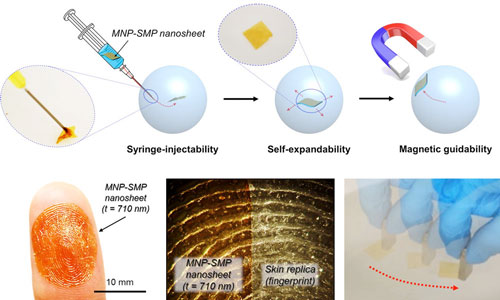| Oct 31, 2019 | |
Syringe-injectable, self-expandable and ultraconformable magnetic nanosheets for smart drug delivery(Nanowerk News) Syringe-injectable biomaterials, medical devices and engineered tissues have attracted great attention as minimally-invasive implants for diagnosis, therapy and regenerative medicine. |
|
| Free-standing polymeric ultrathin films, commonly referred to as polymeric nanosheets, are one of the commonly used platforms for syringe-injectable biomedical devices because of their flexibility and conformability. | |
| These nanosheets are less than 1 micrometer in thickness, which is thinner than a strand of hair that is usually about 100 micrometers wide. They are a promising platform for drug delivery through needle-injection. | |
 |
|
| Concept of syringe-injectable, self-expandable and ultra-conformable magnetic ultrathin films (MNP-SMP nanosheets) composed of polyurethane-based shape-memory polymer and magnetic nanoparticles. (Image: SUTD) (click on image to enlarge) | |
| Despite recent development in nanosheets technologies using polylactic acid (PLA) and polylactic-co-glycolic acid (PLGA), polymeric nanosheets are yet to overcome several technical challenges to serve as an effective injectable platform: namely, 1) limitation in the size of nanosheets injectable through medical needles; 2) suboptimal mechanical robustness (e.g., ripping during injection); and 3) limited control over shape recovery and motion control after injection. | |
| To overcome these limitations, researchers from Digital Manufacturing and Design (DManD) Centre at the Singapore University of Technology and Design (SUTD) developed nanosheets using polyurethane-based shape-memory polymer (SMP) and magnetic nanoparticles (MNP) to demonstrate unprecedented capabilities to handle nanosheets. | |
| SMP offers two unique mechanical characteristics - a large change in the Young's moduli by the change in temperature, and shape-memory effect (SME) to recover the memorised shape (ACS Applied Materials and Interfaces, "Syringe-Injectable, Self-Expandable, and Ultraconformable Magnetic Ultrathin Films"). | |
| In addition, the researchers demonstrated that the fabricated SMP nanosheets can be rendered magnetic with MNP to perform non-contact motion control using an external magnetic field. | |
| Specifically, the following four capabilities were demonstrated by using the 710 nm thick nanosheet with the glass transition temperature (Tg) of 25 °C: 1) syringe-injectability through the medical needles; 2) self-expandability after ejection; 3) conformability and removability on the biological surfaces; and 4) guidability in an external magnetic field. These capabilities enable in vivo practical applications as a syringe-injectable platform. | |
| As an added advantage, the change of the modulus by temperature offers a unique capability to control the adhesion and removal of the MNP-SMP nanosheet on the biological surfaces. This would have been difficult to achieve using conventional nanosheets having a constant modulus and has not been demonstrated previously. | |
| Envisaging the syringe-injectable delivery of molecular drugs or cellular constructs into internal organs, the researchers added the MNP-SMP nanosheets with an additional layer of PLGA, which is best known as a biomaterial used for drug delivery, to extend the functionality as a carrier of molecular and cellular drugs. This can be done without compromising the demonstrated capabilities. | |
| SMP and MNP offered the same capabilities to the nanosheets containing an additional layer of PLGA, suggesting the vast potential of the developed nanosheets for drug and cell delivery. | |
| ?The MNP-SMP nanosheets can be further functionalized by loading or printing drugs, cells and electric circuits on the surface by integrating emerging printing technologies such as inkjet printing, 3D printing and bioprinting,? said Dr Kento Yamagishi from SUTD, the lead author of the paper. | |
| ?The MNP-SMP nanosheets will contribute to the development of advanced syringe-injectable medical devices as a platform to deliver drugs and cells to the specific site or lesion in the body for minimally invasive diagnosis and therapy,? added Principal Investigator, Assistant Professor Michinao Hashimoto from SUTD. |
| Source: Singapore University of Technology and Design | |
|
Subscribe to a free copy of one of our daily Nanowerk Newsletter Email Digests with a compilation of all of the day's news. |
